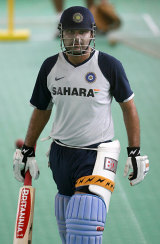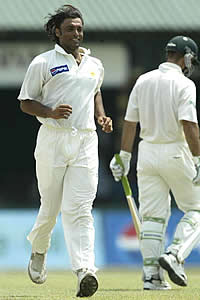Making your debut at 20 can be a nerve-racking experience, and the frissons of nervous energy only intensify if it happens to be in an India-Pakistan game. For Virender Sehwag, the
first foray into the promised land was a fleeting one. He lasted just two deliveries, for one run, before Shoaib Akhtar thudded one into his pads.
Back then, on All Fools' Day in 1999, Shoaib was the hottest ticket in town, all searing pace, flowing locks, and a run-up that seemed to start back in Rawalpindi. A couple of months later he would start the World Cup campaign with a bouncer so quick that Sherwin Campbell looked more flummoxed than anyone else about the top-edged hook that flew for six. It was the first of several spells that would make Shoaib a marquee name, and prompt him to boast: "That World Cup belonged to me."
Indian supporters had become aware of his qualities earlier, during a
Kolkata Test where blistering pace scattered stumps - Rahul Dravid and Sachin Tendulkar off successive deliveries. Wasim Akram had backed his instincts and included Shoaib in place of Waqar Younis, and though whispers abounded over his action, the buzz he created each time he stood at the top of his run-up was a throwback to the glory years of "Lillian Thomson" and the fearsome West Indian quartet.
As for Sehwag, he vanished, as so many from the subcontinent tend to after fluffing their opening lines. It would be nearly two years before he played for India again. And when the day came, the joy of a first match-winning display - 58 and 3 for 59
against Australia in Bangalore - quickly gave way to dismay after he picked up an injury.
By then Shoaib's career was on the skids, sidelined by chucking allegations and poor fitness. He would perform in fits and starts, without ever suggesting that he could discover the consistency that set the game's greats apart from the boys of summer. As someone remarked cruelly, this was a Rolls Royce engine in a jalopy's body.
Sehwag's physique may have been more Beetle than Ferrari but his ascent to the highest echelons was quick. Promoted to open the batting in a one-day game
against New Zealand in Colombo, he lashed a 69-ball hundred, and his Test century on
debut at Bloemfontein a few months later had you breathless with the sheer audacity of the strokeplay.
Shoaib's finest hour, too, came in Colombo, a second-day blitz in a
neutral Test, which those who watched will never forget. But by the time both men arrived at the World Cup in South Africa, their careers were heading in different directions. The
pounding that Shoaib took from Tendulkar encapsulated Pakistan's dismal display, while Sehwag's dashing effort proved to be the only saving grace as Australia ran riot in the
final.
By the time their paths crossed again on India's first tour of Pakistan in a generation, Shoaib's status as pace spearhead was being openly questioned, not least by Inzamam-ul-Haq, his captain. A series that contained one of the immortal sledges - "Tum kyon bheekh maang rahe ho [why are you begging]?" asked Sehwag after Shoaib's attempts to have a chirp
in Multan - came to a farcical conclusion in Shoaib's hometown, Rawalpindi. Having gone off injured while bowling, he came out and smacked two huge sixes as Pakistan slumped to an embarrassing
innings defeat. Up on the balcony Inzamam was incandescent with rage.
Shoaib's brittle physique ruled him out of the return series, and he was eclipsed by Mohammad Asif when India crossed the border in January 2006. If anything, Shoaib caused more of a stir off the field when Greg Chappell commented on his action and Michael Holding followed up with a video analysis of his hyperextension problem.
Sehwag started that series with an astonishing 247-ball 254
in Lahore, but his subsequent slump was to have long-term ramifications. England targeted him ruthlessly with the short ball in a home series, and though he scored runs in the Caribbean against a profligate attack, he was rapidly becoming a liability against the best sides.
Both men reached their nadir in South Africa. Sehwag was a sitting duck for South Africa's pace attack, and innuendo about him being a disruptive influence also played its part in him being jettisoned when the team returned. As for Shoaib, an inspired burst in Port Elizabeth won Pakistan
a Test, but a scuffle with Bob Woolmer and an all-too-predictable injury meant that he was once again headline news for all the wrong reasons.
Until last week he hadn't played for Pakistan since. He was a late withdrawal from the World Cup squad along with Mohammad Asif. Their positive drugs tests before the Champions Trophy had merely been another chapter in a troubled story, and the
dressing-room fiasco on the eve of the World Twenty20 emphasised that Shoaib had exhausted his reservoir of goodwill. One more slip, and he's history.
Sehwag's case is more complicated. One of the great Test openers of the age, he was dropped from the five-day version first, though it was his one-day form that had been wretched for years. His opportunities since have come in the abbreviated formats, and with Wasim Jaffer and Dinesh Karthik seemingly in possession of the Test opening slots, the upcoming one-day series could dictate whether Sehwag's career turns towards redemption or oblivion.
Even without Asif, Pakistan have a formidable attack, and Joe Bloggs could tell you of Sehwag's tendency to be bowled through the gate. Umar Gul, Sohail Tanvir, Rao Iftikhar Anjum and Shoaib will certainly target that vulnerability and Sehwag's ungainliness against the short ball, and if he doesn't come up with an answer, he could end up another Vinod Kambli.
For two men who have thrilled subcontinent crowds as few others have, the stakes couldn't be higher. One has run out of rope and risks being cut adrift, while the other has to prove that he has the hunger to recapture former glories. Shoaib needs to find the inner peace that has always eluded him, while Sehwag has to reinvent a game that has been found out. For cricket's sake, neither must fail.



